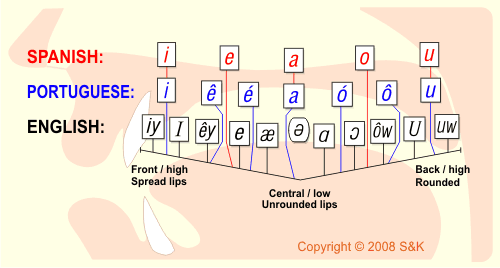
Spanish, Portuguese and English vowel phonemes on the sound spectrum of human speech
Ricardo E. Schütz
Atualizado em 26 de dezembro de 2019
|
PHONOLOGY Each language makes a different use of the articulatory system and phonology is the study of the sound patterns of the language, especially its matrix of phonemes. What is a phoneme? Example 1: Coincidentally in Portuguese the bilabial consonant can also be realized in different ways to produce two different phonemes (ex: pico and bico). Example 2: In Portuguese however there is only one high-front vowel phoneme, as in vida or linda. Any variation in the highness or frontness of this vowel will be perceived simply as variations of the same phoneme. Conclusion: In the beginning learners will perceive sounds in the target language to be phonologically similar to native language sounds. Without proper coaching, they will internalize their own modified phonologigal matrix based on a combination of similar sounds in the two languages, causing "foreign accent". Here I'm going to present the inventory of vowel phonemes of English and Portuguese, as part of the phonological matrixes of the two languages. The language varieties used in this phonological analysis are the American and the Brazilian. When I here refer to vowels, I mean vowel sounds (phonemes). I do not refer to letters of the alphabet (graphemes). VOWELS Vowels are speech-sounds produced by a continuous flow of air and vibration of vocal cords. In the majority of the languages the difference between vowels is perceived not in intensity nor pitch, but in the timbre of the sound. Different timbres are produced by the position of the tongue in the mouth, changing the shape of the oral cavity. Vowel sounds can thus be realized on a continuum by an almost infinite number of intermediate positions of the tongue inside the oral cavity. In less compact languages, with a small number of 1-syllable words and a higher average of syllables per word, the number of phonemes does not need to be large and the difference between each vowel can be bigger. This is the case of Spanish (5 vowel phonemes) and Portuguese (7 vowel phonemes). English, however, is a language extremely economic in the use of syllables, very compact, with a large number of 1-syllable words. Naturally, this requires a larger number of vowel phonemes to supply the bigger "demand" of a system with a reduced number of possible combinations. Phonological systems with a large number of vowel phonemes, require additional hearing accuracy from the speakers in recognition and production. The problem is aggravated by the fact that there are no distinct boundaries between one type of vowel or another. When describing consonants the categories are much more distinct. A sound may be a stop or a fricative, but it can hardly be half way between the two. It is perfectly possible, however, to produce a vowel that is half way between a high vowel and a mid vowel. Therefore, achieving the correct vowel position is perhaps the most significant and persistent problem not only for learners of English as a foreign language that speak Portuguese or Spanish as a native language, but also for speakers of all languages that do not have as large a number of vowels in the spectrum as English. The number of vowels with phonemic significance, therefore, is a determining factor in the degree of difficulty to attain oral proficiency and a good pronunciation. Although in this work we identify only eleven vowels for American English, Mazurkiewicz (69) counted at least fifteen vowels whereas D’Eugenio found even more: “It is a well-known fact that English is phonetically rich in vowels, containing not less than twenty vocalic phonemes (twelve pure vowels and eight diphthongs)” (54). Given the inherent limitations of the human speech articulatory system, it follows that all possible vowel sounds will fall necessarily on the same spectrum (see figure below) and that the difference between one phoneme and the next may well reach the limit of the human hearing perception. The higher the number of vowels, the more subtle the difference among them will be. For this reason, it can become extremely difficult to maintain a clear distinction between phonemes in such an “enriched inventory” of phonemic units (as in English) produced by such a limited articulatory system. This problem is inherently more difficult in the sense of initial language acquisition when it takes longer for the child to learn to distinguish among all the vowels, and particularly harder for the foreign language learner when the native language has a smaller number of phonemes than the target language. The same way that Spanish native speakers have an obvious difficulty to tell apart Portuguese words like pê and pé, vô and vó, Portuguese native speakers will have a hard time hearing the difference between certain English vowels, as we will explain below. NASALITY: One fact to be addressed when analyzing vowel speech sounds is nasality. Nasality is produced by the lowering of the velum, so that part of the air stream is free to pass through the nasal cavity which functions as a resonance chamber. It alters the sound just by adding a new feature but leaving all the other features unchanged and unobscured. Portuguese is notorious for its strong nasality. In certain dialects it can actually be considered phonemic and a stricter phonological analysis of the language would identify at least 3 additional nasal vowel phonemes as demonstrated by the following minimal pairs: lá - lã The fact that Portuguese (as well as French and Polish, among the European languages) makes large use of the additional distinctive phonetic feature of nasalization reinforces the argument presented here. On the one hand, the nasality of Portuguese will represent a difficulty for foreign learners and cause an obvious foreign accent, and on the other hand, it does not help at all Brazilian learners of English. They will actually face two difficulties: suppressing nasality and still dealing with the large inventory of vowel phonemes of English, produced by only one distinctive feature - minimal differences of tongue position. TENSENESS: This is another distinctive feature in speech sounds that deserves attention. Tenseness, produced by the tension of the vocalization muscles, is a characteristic that occurs in 4 of the English vowels while nonexistent in Portuguese. This represents an additional probability of foreign accent for both types of learners. |
FONOLOGIA Cada língua faz um uso diferente do aparelho articulatório, e fonologia é o estudo das características fonéticas da língua, em especial de sua matriz de fonemas. O que é um fonema? Exemplo 1: Coincidentemente, a consoante bilabial também é articulada de formas diferentes para produzir dois fonemas diferentes (ex: pico e bico). Exemplo 2: Em português, entretanto, existe apenas uma vogal alta-frontal, como por exemplo nas palavras vida e linda. Qualquer variação no grau de altura ou frontalidade desta vogal, será percebida simplesmente como variações do mesmo fonema. Conclusão: No início, o aprendiz vai perceber os sons da língua estrangeira como sendo semelhantes aos sons da língua materna. Sem a devida orientação, irá basear sua pronúncia num modelo acústico intermediário entre os sons das duas línguas, ao invés de baseá-la no modelo acústico específico da língua estrangeira, assim como ocorre no aprendizado da língua materna. Em outras palavras, o aprendiz criará e assimilará sua própria versão de matriz fonológica, caracterizando seu "sotaque". Os dialetos usados nesta análise fonológica de vogais são o inglês norte-americano e o português do Brasil e, quando aqui falamos de vogais, estamos nos referindo aos sons e não às letras do alfabeto. Ou seja, estamos falando de pronúncia e não de ortografia; de fonemas e não de grafemas. Por exemplo, nas palavras vô e vó do português temos dois fonemas vogais diferentes. VOGAIS Vogais são sons da fala humana produzidos por um fluxo de ar contínuo, acompanhado de vibração das cordas vocais. O que diferencia uma vogal da outra, na maioria das línguas, não é a intensidade nem a frequência, mas o timbre. Diferentes timbres são produzidos pelo posicionamento da língua na boca, que muda a forma da cavidade bucal. Sons vogais variam portanto de forma contínua, podendo ser produzidos por um número praticamente infinito de posições intermediárias da língua dentro da cavidade bucal. Em línguas menos compactas, com menor ocorrência de palavras monossilábicas e com uma média superior de sílabas por palavra, o número de fonemas não precisa ser tão grande e a diferença entre cada vogal pode ser maior. Este é o caso do espanhol (5 fonemas vogais) e do português (7 fonemas vogais). O inglês, entretanto, é uma língua notadamente econômica no uso de sílabas, compacta, com um grande número de palavras monossilábicas. Isto naturalmente exige um número maior de fonemas vogais para atender a essa maior "demanda" de um sistema com um número reduzido de combinações possíveis. Em sistemas fonológicos com um grande número de fonemas vogais, a diferença entre cada um tende a ser mínima, o que exige uma maior acuidade auditiva de parte dos falantes dessa língua tanto no reconhecimento quanto na produção oral. O problema é agravado pelo fato de que não existem delimitações claras e precisas entre vogais. No estudo da fonologia, a descrição e a classificação das consoantes é muito mais fácil. Um som pode ser uma oclusiva ou uma fricativa, mas dificilmente poderá ser classificado como algo intermediário. É perfeitamente possível, entretanto, produzir sons intermediários entre uma vogal alta e uma média. Portanto, este talvez seja o maior e mais persistente problema não apenas para estudantes de inglês como língua estrangeira que falam português ou espanhol como língua materna, mas para todos aqueles cujas línguas não possuem um número tão grande de vogais dentro do espectro vocálico quanto o inglês. O número de vogais com relevância fonêmica em uma língua é portanto um fator determinante do grau de dificuldade em se obter proficiência oral e uma boa pronúncia. Embora neste trabalho tenhamos identificado apenas onze vogais para o inglês norte-americano, Mazurkiewicz (69) relacionou pelo menos quinze vogais, ao passo que D’Eugenio encontrou ainda mais:
Considerando a anatomia do sistema articulatório humano que produz a fala, suas limitações, e considerando o fato óbvio de que não existem diferenças fisiológicas no aparelho articulatório entre pessoas de diferentes nacionalidades, podemos concluir que todos os sons vogais, de todos os idiomas possíveis, recairão sobre o mesmo espectro (veja figura abaixo) e que as diferenças entre um fonema e outro próximo poderão chegar ao limite da perceptibilidade da audição humana. Portanto, quanto maior for o número de vogais de uma determinada língua, tanto menor e mais sutil será a diferença entre elas. Desta forma, torna-se muito difícil manter uma distinção clara entre vogais dentro de um inventário tão repleto de fonemas (como no inglês) e, ao mesmo tempo, produzido por um aparelho articulatório tão limitado. Em primeiro lugar, este é um problema que afeta a assimilação da língua materna, fazendo com que a criança leve mais tempo até conseguir distinguir todas as vogais. Em segundo lugar, e com maior insistência, o estudante de língua estrangeira será afetado, principalmente quando a língua materna tiver um número de vogais menor do que o número de vogais da língua estrangeira. Da mesma forma que falantes nativos de espanhol exibem uma notória dificuldade em distinguir as vogais do português nas palavras pê e pé, vô e vó, também nós que temos o português como língua materna, temos dificuldades evidentes em distinguir determinadas vogais do inglês, como será mostrado abaixo. NASALIDADE: Uma questão a ser analisada no estudo da fonética, é a nasalidade. A nasalidade é produzida pelo rebaixamento parcial de uma membrana chamada palato mole ou véu palatino, de maneira que nas vogais, parte do fluxo de ar passa através da cavidade nasal, a qual funciona então também como câmara de ressonância. Isto altera o som apenas pelo fato de acrescentar uma característica nova, deixando as demais características da vogal inalteradas. O português é notório pela forte nasalidade que o caracteriza. Em alguns dialetos, esta nasalidade pode adquirir relevância fonêmica (não apenas fonética) e uma análise fonológica minuciosa da língua vai identificar pelo menos 3 fonemas vogais nasais além dos relacionados neste estudo, como demonstram os seguintes pares mínimos: lá - lã O fato de o português (assim como também o francês e o polonês) fazer largo uso da nasalidade reforça o argumento aqui apresentado. Por um lado, a nasalidade do português representa uma dificuldade para aprendizes estrangeiros, se constituindo em mais um elemento causador de interferência e sotaque. Por outro lado, a nasalidade do português em nada ajuda seus falantes nativos em seu aprendizado de línguas estrangeiras. Pelo contrário, os aprendizes brasileiros de inglês, enfrentam uma dupla dificuldade: eliminar a nasalidade ao mesmo tempo em que enfrentam o desafio de assimilar um sistema com um número maior de vogais cuja única característica diferenciadora são as mínimas diferenças no posicionamento da língua. TENSÃO: É outra característica diferenciadora na articulação de sons vogais que merece atenção. Produzida pela tensão dos músculos articuladores, é uma característica que pode ser observada em 4 das vogais do inglês, enquanto que inexistente em português. Representa portanto uma probabilidade adicional de sotaque estrangeiro, tanto para aprendizes brasileiros de inglês como para falantes nativos de inglês que aprendem português como língua estrangeira. |

| The above English vowel phonemes occur in words like: | Os fonemas vogais do inglês, acima representados, ocorrem tais como nas palavras: | The above Portuguese vowel phonemes occur in words like: | Os fonemas vogais do português, acima representados, ocorrem tais como nas palavras: | |
|
/I/ - bit /bIt/ /êy/ - bait /bêyt/* /e/ - bet /bet/ /æ/ - bat /bæt/ /a/ - father /'faðər/ /ə/ - but /bət/ /ɔ/ - bought /bɔt/ /ôw/ - boat /bôwt/* /U/ - book /bUk/ /uw/ - boot /buwt/* |
/ê/ - ele /êli/ /é/ - pé /pé/ /a/ - lá /la/ /ó/ - pó /pó/ /ô/ - ovo /ôvu/ /u/ - uva /uva/ |
|||
| * Glided and tense vowels: For the representation of the English glide vowels (also called tense vowels) I prefer a two-character transcription including the off-glides, to distinguish them from the lax vowels. |
OBS: Omitimos aqui as vogais nasais na descrição
fonológica
do português, em benefício de uma maior simplificação. |
|||
|
PROBABLE ERRORS WITH VOWELS: These are the most common errors with the English vowels made by Portuguese native speakers. |
PROVÁVEIS ERROS COM VOGAIS: Estes são provavelmente os erros mais comuns com as vogais do inglês de estudantes cuja língua materna é português. |
|
bead /biyd/ - bid /bId/ beat /biyt/ - bit /bIt/ bean /biyn/ - bin /bIn/ cheap /tshiyp/ - chip /tshIp/ cheek /tshiyk/ - chick /tshIk/ eat /iyt/ - it /It/ feel /fiyl/ - fill /fIl/ feet /fiyt/ - fit /fIt/ green /griyn/ - grin /grIn/ heat /hiyt/ - hit /hIt/ heel /hiyl/ - hill /hIl/ lead /liyd/ - lid /lId/ leap /liyp/ - lip /lIp/ least /liyst/ - list /lIst/ |
meal /miyl/ - mill /mIl/ neat /niyt/ - knit /nIt/ peel /piyl/ - pill /pIl/ reach /riytsh/ - rich /rItsh/ read /riyd/ - rid /rId/ scene /siyn/ - sin /sIn/ scheme /skiym/ - skim /skIm/ seat /siyt/ - sit /sIt/ seek /siyk/ - sick /sIk/ sheep /shiyp/ - ship /shIp/ sheet /shiyt/ - shit /shIt/ sleep /sliyp/ - slip /slIp/ steal /stiyl/ - still /stIl/ wheel /wiyl/ - will /wIl/ |
 |
|
|
|
 |
|
|
|
|
|
beg /beg/ - bag /bæg/ dead /ded/ - dad /dæd/ end /end/ - and /ænd/ flesh /flesh/ - flash /flæsh/ gem /dzhem/ - jam /dzhæm/ guess /ges/ - gas /gæs/ head /hed/ - had /hæd/ |
men /men/ - man /mæn/ met /met/ - mat /mæt/ pen /pen/ - pan /pæn/ said /sed/ - sad /sæd/ send /send/ - sand /sænd/ shell /shel/ - shall /sæl/ then /ðen/ - than /ðæn/ |
 |
 |
||
|
See more about vowel reduction at: http://www.sk.com.br/sk-reduc.html |
Veja mais sobre redução de vogais em: http://www.sk.com.br/sk-reduc.html |
|
|
|
cot /kat/ - caught /kɔt/ are /ar/ - or /ɔr/ |
 |
|
|
|
|
 |
Azevedo, Milton M. A Contrastive Phonology of Portuguese and English. Georgetown University, 1981.
Dauer, Rebecca M. Accurate English: a Complete Course in Pronunciation. Prentice Hall Regents, 1993.
D'Eugenio, Antonio. Major Problems of English Phonology. Foggia, Italy: Atlantica, 1982.
Mazurkiewicz, Albert J. Teaching about Phonics. New York: St. Martin's, 1976.
Nilsen, Don L.F., and Alleen Pace Nilsen. Pronunciation Contrasts in English. New York: Regents, 1973.FAÇA AQUI UM TESTE PARA AVALIAR O QUE VOCÊ SABE A RESPEITO DE PRONÚNCIA
STUDY PORTUGUESE IN BRAZIL
Como fazer uma citação desta página:
Schütz, Ricardo E. "Os Fonemas Vogais do Inglês e do Português." English Made in Brazil <https://www.sk.com.br/sk-voga.html>. Online. (data do acesso). Observe que ao citar textos encontrados na Internet, é necessário colocar a data, devido às frequentes alterações que os mesmos podem sofrer. Estes materiais são propriedade intelectual de S&K - ESL, nosso patrocinador
Não deixe de citar a fonte. Diga não ao plágio.